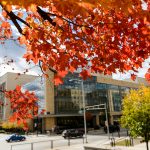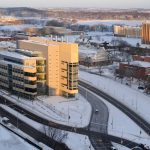Research Highlights 2000 – 2023
2000 – First Graduate Research Scholars (GRS) Program formed in the College of Engineering, founded by Prof. Douglass Henderson(Graduate Engineering Research Scholars – GERS). Graduate Research Scholar (GRS) communities are organized by the various schools and colleges within UW–Madison to support underrepresented students. These GRS Fellowships, with funding from the State of Wisconsin Advanced Opportunity Program and the Wisconsin Alumni Research Foundation, bring students together in GRS communities throughout their graduate school career for a range of social, academic, professional development, and research-related activities. https://grad.wisc.edu/funding/graduate-research-scholars/
2000 – Governor Tommy Thompson announces the BioStar initiative to build a series of state-of-the-art research centers on campus. The initiative will fund expansion to the Biochemistry Complex, the Biotechnology Center and a new Microbiology Building.
2000 – Alan MacDiarmid wins the Nobel Prize in Chemistry for the discovery of polymers that conduct electricity.
2000 – Jack St. Clair Kilby wins the Nobel Prize in Physics for the invention of integrated circuit.
2003 – The Delta Program in Research, Teaching and Learning is launched as a member of the Center for the Integration of Research, Teaching and Learning (CIRTL) to provide professional development programming designed for graduate students and postdocs to develop a national faculty committed to implementing and advancing effective teaching practices for diverse student audiences.
2003 – The University of Wisconsin Water Resources Institute has a long history of researching naturally occurring radium in the state’s groundwater—where it is, how much there is and how it might move around—all critical to know because of radium’s negative effects on human health. Early research on radium has led to the city of Waukesha now being able to get drinking water from Lake Michigan. Current work is focused on treating drinking water and adjusting well casings or altering pumping depths. Links: https://www.wri.wisc.edu/news/radium-and-strontium-researchers-take-a-seat-at-the-table/ https://www.wri.wisc.edu/news/radium-and-strontium-researchers-take-a-seat-at-the-table/ https://www.epa.gov/wifia/waukesha-great-lakes-water-supply-project
2003 – Wisconsin Alumni Research Foundation (WARF) is awarded the National Medal of Technology and Innovation by President George W. Bush https://nationalmedals.org/laureate/wisconsin-alumni-research-foundation-warf/
2004 – The Graduate School celebrates its 100th anniversary.
2005–- Psychologists at UW–Madison demonstrate for the first time that severe neglect and social isolation can directly affect a young child’s neurobiology in ways that potentially influence emotional behaviors. Senior author is Seth Pollak, a UW–Madison professor of psychology, psychiatry and pediatrics and researcher at the Waisman Center for Human Development. The work is reported online in the Nov. 21, 2005 Proceedings of the National Academy of Sciences. https://news.wisc.edu/psychologists-glimpse-biological-imprint-of-childhood-neglect/
2007 – A team of UW–Madison researchers reports the genetic reprogramming of human skin cells to create cells indistinguishable from embryonic stem cells. The UW–Madison team was led by Junying Yu and Jamie Thomson.
2007 – UW–Madison is named to lead the Great Lakes Bioenergy Research Center, a consortium of universities, the Department of the Energy and businesses launched to explore the vast potential of bioenergy.
2007 – UW–Madison Stem Cell and Regenerative Medicine Center is launched to serve as an intellectual and collaborative hub for interdisciplinary research in the field.
2007 – Yoshi Kawaoka, Gabrielle Neumann and Paul Radspinner found FluGen, Inc. dedicated to preventing and treating seasonal and pandemic outbreaks. The company draws upon the revolutionary “reverse genetics” techniques developed by Kawaoka for flu vaccines. https://news.wisc.edu/warf-licenses-influenza-vaccine-technology-to-flugen/
2007 – Computer Science Professor Guri Sohi and his laboratory invent a processing circuit that allows computers to run multiple instructions at once. The technology has gone on to be used in several generations of smartphones and tablets around the world.
2007 – Oliver Smithies wins the Nobel Prize in Physiology, Medicine for introducing specific gene modifications in mice using embryonic stem cells.
2010 – UW–Madison and UW–Milwaukee, the state’s two public doctoral institutions, join forces in the first campus-wide program to promote collaborative research projects involving faculty at both universities.
2010 – The Andrew W. Mellon Foundation awards a $10 million grant to preserve and enhance the humanities at UW–Madison, which is matched by $10 million from the state. In the Graduate School, funding is used to support graduate student at all stages in their career.
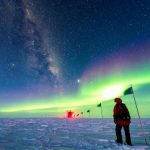 2010 – The IceCube neutrino observatory in Antarctica is completed.
2010 – The IceCube neutrino observatory in Antarctica is completed.
2010 – Twenty-three UW–Madison doctoral programs are ranked in the top 15 percent in their respective fields, according to an assessment by the National Research Council.
2010 – UW–Madison reaches $1 billion in research expenditures for the first time.
2010 – The Wisconsin Institutes for Discovery opens. In 2012, the facility is named Laboratory of the Year by R&D Magazine.
2010 – UW–Madison forms their chapter of the Edward Alexander Bouchet Graduate Honor Society.
2011 – Wisconsin National Primate Research Center (WNPRC) Scientists James Thomson and Igor Slukvin turn diseased cells from a leukemia patient into pluripotent stem cells, providing a way to study the genetic origins of blood cancers as well as the ability to grow unlimited cells for testing new drugs for chronic myeloid leukemia, childhood leukemia and other blood cancers. http://www.news.wisc.edu/18933 and http://www.ncbi.nlm.nih.gov/pubmed/21296996
2011 – The Office of Industrial Partnerships is created to foster collaboration between researchers and industry.
2012 – NPP satellite renamed Suomi NPP. is the first weather satellite to be named after a scientist, Verner Suomi, the father of satellite meteorology and founder of UW–Madison Space Science and Engineering Center.
2012 – In the first decade of the 2000’s, a Wisconsin Sea Grant staff member worked with numerous federal, state and local partners to design a restoration plan for the Cat Island Chain of barrier islands in Green Bay that had been lost to Lake Michigan’s waves. With that loss went habitat for plants, waterfowl, reptiles and small mammals. The islands had also protected the mainland from storms. In 2012, restoration began using dredged material from the shipping channel to bring back 1,400 island acres. https://www.seagrant.wisc.edu/our-work/focus-areas/coastal-processes-and-engineering/cat-island-chain/
2013 – The Wisconsin Energy Institute, a center for clean energy research and education, opens.
2013 – Ei Terasawa, PH.D., and her lab members at the Wisconsin National Primate Research Center discover that the brain, not just the ovaries, can produce and release estrogen. This discovery may lead to a better understanding of hormonal changes observed from before birth throughout the entire aging process. “These findings not only shift the concept of how reproductive function and behavior is regulated but have real implications for understanding and treating a number of diseases and disorders,” Ei Terasawa. https://news.wisc.edu/estrogen-not-just-produced-by-the-ovaries/
2013 – IceCube discovers energetic neutrinos originating beyond our galaxy, opening a new window onto the universe. https://icecube.wisc.edu/news/press-releases/2013/11/icecube-pushes-neutrinos-to-forefront-of-astronomy
2014 – The Faculty Senate approves a reorganization of leadership in the university’s research and graduate education enterprise, dividing the responsibilities into two positions – the Vice Chancellor for Research and Graduate Education and the Dean of the Graduate School.
2014 – Launch of Discovery to Product (D2P).
2015 – William C. Campbell win the Nobel Prize in Physiology, Medicine for the dscovery of drug that lowers incidence of tropical diseases.
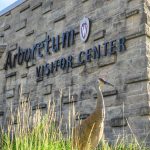
A pair of sandhill cranes stand in front of the Arboretum Visitor Center. (Photo by Althea Dotzour / UW–Madison)
2015 –UW Arboretum is listed on the Wisconsin Register of Historic Places.
2015 – Space Science and Engineering Center celebrates 50th anniversary.
2016 – Mercury in the body acts as a neurotoxin, disproportionately affecting the health of children and pregnant women. In 2016, a University of Wisconsin Water Resources Institute researcher published findings about developing a “fingerprinting” technique for determining the sources of mercury in the Great Lakes. It’s a tool that can be applied worldwide to understand where mercury is coming from, so it can be cleaned up and even be prevented from getting into ecosystems in the first place. Links: https://www.seagrant.wisc.edu/news/new-fingerprinting-tool-determines-great-lakes-mercury-sources/ https://www.seagrant.wisc.edu/news/aquatic-invasive-species-are-short-circuiting-benefits-from-mercury-reduction-in-the-great-lakes/
2017 – UW–Madison ranked 1st in the US for the number of doctoral degrees conferred in a year. UW–Madison alumni go on to a variety of successful careers across the academy, for-profit and non-profit sectors, industry, government, education, and more. https://grad.wisc.edu/alumni-careers/
2017 – The Council of Graduate Schools selects the UW-Madison to take part in the PH.D career pathways project to survey both alumni and current students to gain insight into career preparation, training and professional development, career outcomes and tracking of employment over time.
2017 – UW–Madison is one of 10 founding members of the Coalition for Next Generation Life Science to shine light on life science trainee data by publishing data using common data standards for admissions, matriculation, time-to-degree, completion, demographics and career outcomes for PH.D students and postdoctoral scholars.
2018 – The active galaxy TXS 0506+056, whose center contains a supermassive black hole, emerges as the first source of high-energy neutrinos from a multimessenger campaign involving more than twenty telescopes alerted by a high-energy neutrino observation by IceCube. https://icecube.wisc.edu/news/press-releases/2018/07/icecube-neutrinos-point-to-long-sought-cosmic-ray-accelerator/
2018 – The Vilas trust provides over $1 million in travel funding for graduate students as part of the Student Research Grants Competition (SRGC).
2019 – American Family Insurance Data Science Institute opens on campus to further promote collaboration on research across campus. American Family Insurance contributes a $10 million endowment and commits an additional $10 million for data science research over 10 years. DSI leads UW-Madison’s data science efforts on campus and beyond by providing data science services for campus, community, and industry partners, and communicating research, education, and training opportunities in data science at UW.
2019 – The Center for Genomic Science Innovation opens with the goal of developing innovative technological and computational genomic approaches to address modern problems in medicine, agriculture and basic scientific discovery.
2019 – Almost a decade after construction was completed, IceCube receives funding to add seven more densely instrumented strings of sensors near the center of the existing array to better measure neutrino and ice properties and test new instruments. https://icecube.wisc.edu/news/press-releases/2019/07/nsf-mid-scale-award-sets-off-first-extension-of-icecube/
2019 – The Graduate School establishes a graduate student advisory board to help advise the Graduate School Dean on issues important to graduate schools and provide a diverse array of perspectives from different academic disciplines.
2019– The School of Education becomes ranked 2nd in U.S News Rankings. This is the 5th year in a row that the School of Education has been ranked in the Top 5 overall for the Best Graduate School in Education.
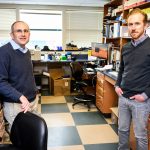
Researchers David O’Connor, left, and Tom Friedrich, right. Both are experts on the evolution and emergence of HIV (AIDS), SARS-CoV-2 (COVID-19), influenza, Zika and other viruses. (Photo by Jeff Miller / UW-Madison)
2020 – SARS-CoV-2 research helps lead to vaccines for COVID-19. Professors David O’Connor, Thomas Friedrich and other scientists at UW–Madison, the Wisconsin National Primate Research Center (WNPRC) and their collaborators elsewhere characterize transmission and pathogenesis of SARS-Co-V2 early in the pandemic, through comparative human and animal studies that helped lead to effective vaccines involving preclinical testing in monkeys, then clinical testing in humans. The UW–Madison and WNPRC global infectious diseases team has also contributed to advancing knowledge and therapeutic approaches for HIV, Ebola, dengue, Zika and other viruses.
2020 – Biotron Laboratory ends its 50-year run. https://news.wisc.edu/biotron-celebrates-storied-history-as-it-ends-50-year-run-as-a-research-center/
2021– Enrollment of underrepresented students of color exceeds 1,000 graduate students for the first time.
2021 – UW Arboretum is named a National Historic Landmark. “The Arboretum’s landmark designation is based on a “period of national significance” that begins in 1933 with the first forest plantings. Notable experiments sought to understand and restore prairie, savanna and marsh communities; study fire ecology and test the use of prescribed fire; and implement an adaptive approach to land management, incorporating built-in experiments designed to inform practice. This period ends in 1966 with the retirement of G. William Longenecker, executive director from 1933–66, and the death of Henry Greene, instructor in the UW–Madison botany department and collection curator in what is now the Wisconsin State Herbarium.” – from National Historic Landmark announcement
2022 – After a decade of data accumulation and improvements to detector sensitivity, IceCube reveals more sources of high-energy neutrinos produced near the cores of galaxies hosting a supermassive black hole at their centers, most prominently the active galaxy NGC 1068. https://icecube.wisc.edu/news/press-releases/2022/11/icecube-neutrinos-give-us-first-glimpse-into-the-inner-depths-of-an-active-galaxy/
2022 – IceCube presents the design of a next-generation neutrino telescope with a sensitivity improved by an order of magnitude. The concept received endorsement by the Decadal Survey on Astronomy and Astrophysics. https://icecube.wisc.edu/news/detector/2021/11/icecube-gen2-convenes-to-kick-off-technical-design-report/
2020 – The National Oceanic and Atmospheric Administration renews its partnership with UW–Madison to conduct research in satellite meteorology through its Cooperative Institute for Meteorological Satellite Studies.
2020 – The Water Resources Institute and Wisconsin Sea Grant forge partnerships with state agencies to offer post-graduate fellowships, allowing agencies to tackle challenging issues using fellows with cutting-edge knowledge. The fellows get professional mentoring early in their careers. In 2020, a Water Resources-Wisconsin Department of Health Services fellow developed groundwater standards for 16 forms of per- and polyfluoroalkyl substances (PFAS). PFAS substances are dangerous to human health. Links: https://www.dhs.wisconsin.gov/chemical/pfas.htm#:~:text=Recommended%20groundwater%20standards,-PFOA%20%3D%2020*&text=All%20numbers%20are%20shown%20as,NEtFOSA%2C%20NEtFOSAA%2C%20and%20NEtFOSE.
https://www.seagrant.wisc.edu/news/sea-grant-hires-new-emerging-contaminants-staff-scientist/
2023 – Institute on Aging 50th anniversary, Learn more about its history at https://aging.wisc.edu/ioa-history/
2023 – Waisman Center celebrates its 50th anniversary.
2023 – UW researchers identify cell type that could be key to preventing marrow transplant complication https://news.wisc.edu/uw-researchers-identify-cell-type-that-could-be-key-to-preventing-marrow-transplant-complication/
2023 – UW-Madison develop a way to move therapies across the brain’s protective membrane to deliver brain-wide therapy with a range of biological medications and treatments. These new nanocapsules deliver therapy brain-wide, edit Alzheimer’s gene in mice https://news.wisc.edu/new-nanocapsules-deliver-therapy-brain-wide-edit-alzheimers-gene-in-mice/
2023 – Lab-grown retinal eye cells make successful connections, open door for clinical trials to treat blindness https://news.wisc.edu/lab-grown-retinal-eye-cells-make-successful-connections-open-door-for-clinical-trials-to-treat-blindness/
2023– UW–Madison is one of the world’s leading research institutions with nearly $1.4 billion in annual research expenditures.

